WE SERVE TO SAVE
The Air Force at SeabyGuy Ellis
Editor |
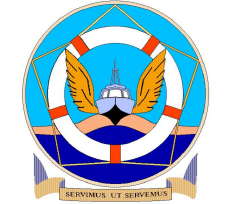
|
The Air Force at SeabyGuy Ellis
Editor |

|
|
It was only in 1969 that the South African Air Force relinquished its
maritime element to the South African Navy. Initially formed in
1939, to act as practice targets, the service soon grew to perform a
proud and valuable service to not only the Air Force, but also to the
broader community.
The Beginning12 Motor Boat Section was established at Gordon's Bay in December 1939. This was a detachment of the Air Armament Training School at Youngsfield, which up until the outbreak of war had been known as the Cape Air Training School. Its purpose was to operate a 40ft armoured target boat for the SAAF pilots to practice attacks at sea. This boat known as Malgas, was fitted with seven tons of armoured steel over the steering position, engine room and on the sides of the boat as protection for the crew of coxswain, mechanic and radio operator and the engines. 15 Squadron, 32 Coastal Squadron, 32 Coastal Flight and others used the 12,18m vessel as a target on the bombing and air gunnery range at Strandfontein. A batch of boats was ordered from the British Power Boat Co of Hythe, owned by Hubert Scott-Paine. He had been involved with the design of some Schnieder Trophy contenders and had developed a 64ft twin screw boat powered by two Rolls Royce Merlin engines. It was this type that was selected to equip the SAAF Motor Boat Section. The first of these, christened Malmok (the black browed Albatross) arrived with a second armoured boat, the Malgas II, on 11 March 1940. Accompanying these boats was A D Boyle, (later Commander) who had been released from duties with the British Power Boat Company for special duties with the South African Government (Defence). Mr Boyle had been responsible for crew training for the Imperial Airways flying boat service and had been seconded on the request of General Sir H.A. (Pierre) van Ryneveld. The two met when they were aboard a rescue launch during sea trials. As Chief of the South African Air Force, General van Ryneveld inspected the Gordon's Bay installation on 23 March 1940. As a result of this visit on 1 May 1940 12 Motor Boat Section became the Motor Boat Wing ofthe SAAF, and was transferred from Air Armament Training School to Deputy Director of Coastal Forces. Gordon's Bay became an official Air Force Base on 11 May 1940. Based here were the support services, main workshops and stores. Shortly afterwards a Navigation School and Marine Engineering School were established. The rescue launch was fully employed, as there was a considerable amount of flying. The crew was at sea for most of the day and the craft was serviced at night. When not required for operations or target duty, all the craft were used for the training of boat crews and base staff for the rescue launches that were due to arrive in South Africa.
RAF RequirementsFavourable climatic conditions and the possibility of extended flying hours led the Royal Air Force to establish coastal based flying schools in South Africa. This and other colonial based training programs formed the Empire Training Scheme. Such operations required rescue and support services, such as those in their infancy at Gordon's Bay.It was decided that the SAAF Motor Boat Section would train all RAF maritime rescue and tender crews. The first group from No 61 Air School George began their training at Gordon's Bay on 29 December 1940. At the height ofthe war it is recorded that the station had a total strength of 1500 officers, airmen and airwomen, ofwhich 40 percent were RAF personnel under training. Integration was so complete that when RAF personnel came to determine the progress of their men, it was impossible to determine which men belonged to which force.
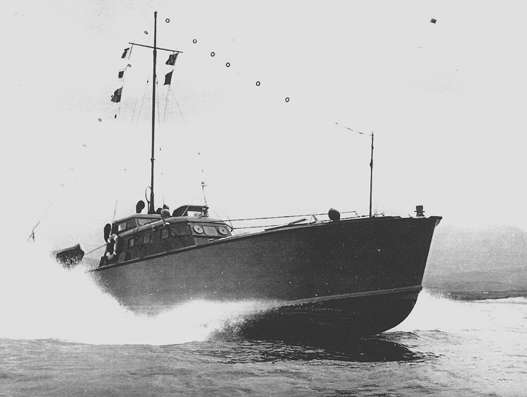 Malmok at speed Further expansion took place in October of that year with the acquisition of a target service craft Cannuk. Although training took place in readiness for the launches due from England, no more were forthcoming, as their Merlins were far more useful powering Spitfires fighting the Battle of Britain.
ProcurementThe South African Government had established a Purchasing Mission (SAPURCON) in the United States of America, to acquire materials that were not available or that could be made in England or South Africa. One ofthe members ofthis commission Mr J F Finlay had been recalled from Kenya in May 1940, where he was supervising the erection of Bellman Aircraft hangers. He was instructed to join the mission in the USA as Technical Advisor. Travelling by Japanese ship from Cape Town to Rio de Janeiro, and from there to New York, he arrived on 4 July 1940. The British Purchasing Commission located at 37 Wall Street had spare accommodation which they allowed the South African group to use.During August/September Finlay received a telegram authorising the acquisition of eight craft capable of 40 knots and containing a dispensary with accommodation for six beds. Amongst other requirements was that ofa well deck. Although unsure of the specifications Finlay had become friends with the Naval Architect of the British Commission who explained the concept of the crash boat. As a result of this friendship, Finlay was introduced to Mr Dair N. Long, a naval architect at the University of Michigan. Mr Long prepared a design and within a few weeks tenders were called for and then issued to the Miami Shipbuilding Corporation of Florida. Within a short space of time Mr Finlay was requested to attend the sea trials of the first boat. He records that although he had in the past faced danger, he found the high- speed trials to be terrifying. Following the successful completion of these trials, R1 to R4 were loaded aboard an American/South African Line vessel, for shipment to Cape Town and they arrived on 20 May 1941. The second four R5 to R8 arrived on 24 July 1941. Vessels R3, 7 and 8 formed 3 Motor Boat Section based at Gordon's Bay.
Into OperationWith sufficient boats and trained crews, more Motor Boat sections were created. Further Maritime Craft Flights were established at Mossel Bay, Port Elizabeth, Durban, (2 Flights on Salisbury Island) Walvis Bay and Saldanha.The crash boat's complement of nine consists of the Officer in charge, two Coxswains, two engineers, two deck hands, the Wireless Operator and the Medical Orderly 2 Motor Boat Section was formed in Cape Town June 1942, and assisted in searches for both the SAAF and Fleet Air Arm. In January 1945, on the completion ofthe Murray's Bay harbour, it transferred to Robben Island where it was disbanded in November 1945. R9-20 arrived from January 1944 onwards. These were Miami Craft Mk II with the same hulls but an improved centre cabin layout and the addition of a flying bridge, with duplicate controls. A tripod mast incorporating a searchlight replaced the pole mast fitted to the earlier boats. Sailor's superstition meant that no one would crew R13 so it was number R20. In line with this numbering system the British boat Malmok became RO. A fleet this size enabled the stationing of two vessels at each operational flight and a double flight at Durban. Operating in many cases simply from the quayside there was never a call that was not responded to, no matter what the sea conditions. From Gordon's Bay the maximum amount of time from call to being at sea was four minutes. While at sea it was impossible to use the fo'c'sle accommodation area due to the extreme movement in the bows. The most comfortable cabin for off duty crew at sea, were the NCO bunks in the stem and after that the wardroom in the centre of the boat.
Repairs and MaintenanceThe support staff maintained the boats and the operations under very rudimentary conditions. For most of the war, offices and workshops were converted double sided aircraft crates, which proved adequate for the job. First and second line servicing was carried out on the launches, while the more extensive third and fourth line maintenance was completed at Gordon's Bay.
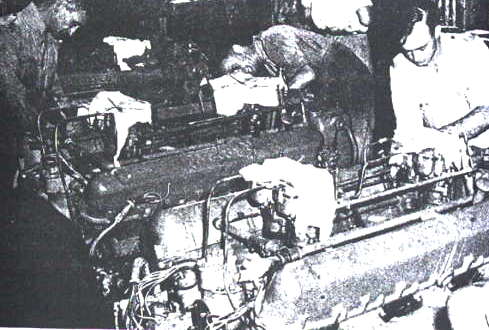 At work on the engines Numerous serious problems were experienced early in the life of the launches and it is a tribute to the men involved that all the boats remained operational. Within a short time of coming into service it was found that the main hull spats were breaking up, as the boats were not designed for South African coastal conditions. All the boats were virtually rebuilt by the highly skilled SAAF personnel, who manufactured new aluminium rails for the engines and new spars more suited to South African conditions. It was clear that the engines of R9-20 had never been run before shipment to South Africa. There had been a change in the hull design and the result was a very shallow sump dish. When the forward engines were started, only frothy oil passed through the oil filters, which indicated a restricted oil flow. The first four of these boats had been unloaded in Durban and a full technical team had to go there to find a solution to the oil problem. This meant that the decks had to be lifted and plates attached to the cylinder head to be able to remove the motor for inspection and rectification. It was found that the shallowness of the sump meant that the oil never settled enough and was being churned up and aerated. Because it was not possible to amend the hull itself, the sumps had to be modified to allow oil to sink and remove the air. Channels were built into the sump into which the oil was forced and could then flow through to the filters free of excess air. These structural and design issues were further complicated by the lack of glue adhesion and teredo wood boring worms. The Gordon's Bay technicians set up hundreds of tests to determine the most suitable glue to be applied. Wooden strips 9" x 1" xl" were attached to metal plates and these were in turn attached to the harbour wall. The rise and fall of the tide and the exposure to the elements adequately simulated operations and allowed the technicians to select the best glue and the most effective method ofapplication.
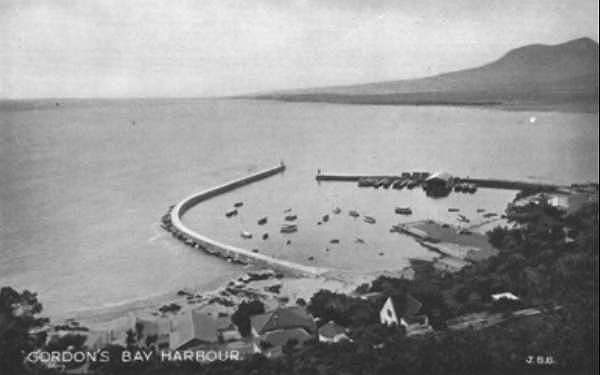 Gordon's bay Station(Courtesy Capt B Rice) The hulls ofthe launches were not coated with copper as protection against worms and therefore some alternative had to be developed. Once again Gordon's Bay harbour doubled as a maritime laboratory. A sailing boat, riddled with worm, was employed as the test bed. Various pieces ofwood, impregnated and painted with various coatings were attached to the vessel.'Ihe result was that a bitumastic solution, made in Holland for Shell to paint fuel storage tanks, thinned with paraffin was applied and finished with a cheap anti foul coating. No worms were experienced in over twenty years of operation. This was helped by the routine of opening every boat every day to allow air to flow and to combat wood rot. Further local modifications were made to improve the operation of the boats. The aft engine was only engaged via a clutch, once the launch was at sea, the forward engine alone being used for manoeuvring in harbour. To be able to balance power between the engines once the aft engine was engaged, vacuum gauges were fitted.These initially came from commercial refrigeration units, but later units from crashed Italian aircraft were found more suitable. The radio sets provided proved inadequate and were replaced with aircraft sets and placed as far aft as possible. In any sea at speed, the magnetic compasses became inaccurate. Once again the craftsmen of the unit had to devise an alternative fitting that would provide the crew with fully operational equipment.
Operational RecordIn 1942 the command structure of the Motor Boat Wing was re- organised. Operational command was vested in the Commander Fortress Air Defence at Cape Town, and the detached flights were operated through the local Coastal Air Defence organisation. Technical command was transferred to Maintenance Command at Roberts Heights while a self accounting administrative command remained at Gordon's Bay.The SAAF operated crash boats were responsible for the saving of almost 600 lives around the coast of South Africa, in the period 1939 to 1945. The first rescue operations occurred during January to March 1941, when the crews of three fishing vessels were saved in different operations in severe gales.The crews at Gordon's Bay were well known for their civic action, from saving spotters on the bombing range in a flooded river to evacuating residents whose homes were threatened by fire. German submarines and surface raiders were very active off the South African coast, claiming 133 and 20 ships respectively. The crash boats were involved in many operations related to these sinkings, bringing in during November 1942 in 106 survivors of U- boat attacks. MishapsDuring the war, three rescue launches and a refuelling tanker ran aground. R2 ran aground at Robben Island, R8 at Still Bay, R10 at Strandfontein and the tanker at Skaapen Island, Langebaan. Such was the shortage of equipment that it was necessary for these to be salvaged, repaired and returned to service.R2's mishap occurred when she was out at sea with a party of city and defence officials who wished to determine the success of the black out in Cape Town. In those days there were none of the current navigational aids and R2 ran up on the rocks on the north- west corner of Robben Island. At the time, a landing strip was being built on the island and the equipment on site was used to salvage the launch. A cradle was built onto rail bogies and rail lines laid. The boat was then taken across the island, with lines being laid in a leapfrog fashion until re-launching could take place in Murray' Bay, where the harbour is now located. The most difficult of the salvage operations was the recovery of R8. On 19 December 1943, R8 was returning to Mossel Bay after an extended search for survivors from torpedoed ship. Due to darkness and poor navigation equipment, the launch struck the outer edge of Morris Point. In spite of throwing out two anchors, the vessel was driven onto the rocks by the strong swell .
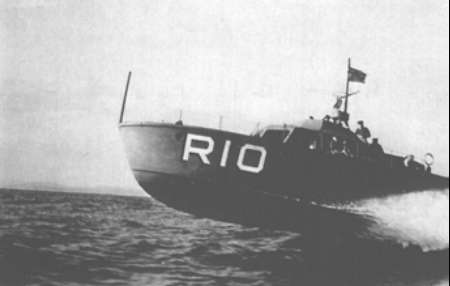 R10 before her demise A salvage team from Gordon's Bay set out with flotation equipment and a rocket line was organised from the South African Railways and Harbours at Mossel Bay. A tug was despatched to the scene and the salvage team passed a line from the shore to the tug. While the line was being hauled in it snapped. The severe weather conditions did not allow for the tow line to be re-connected. R8 was thrown further on to the rocks, suffering more damage to the hull. It was decided to salvage all equipment including the four engines, which were stripped down and taken ashore. A donkey cart then transported these items to the nearest road and they were taken to AFS George for cleaning. Because of the shortage of craft, the Chief of the Air Force approved a recovery operation of the hulk. Six men from Gordon's Bay and twenty from George went about the task. A wooden cradle was built under the boat so as to be able to haul the boat over the rocks. The cradle was washed away repeatedly, until at last on the third day the hull was out of reach of the sea. All the gullies between the rocks had to be filled with stones and sand to form a roadway. Then a road 2800ft, long was cut through the dunes to the nearest beach. Gum poles banded together with wire were buried into the sand, block and tackle attached and in turn linked to the boat. The remains of R8 were hauled 150 feet at a time to the beach. For each cycle the gum poles were dug up and moved forward and buried again in a leap frog fashion, which would explain why it took five days to complete the operation. Men working from underneath, filled the hull with empty drums and then the bottom was tarred and covered with army blankets and sheets of metal 6 feat by 3 foot were nailed on. When fully prepared, the men turned the bow to the sea and anchored the stern. A sisal line, selected because of its buoyancy and stretchability, was passed to a tug standing off shore. After steaming a full speed for ten minutes the stem lines on R8 were cut. The boat was catapulted 200 yards out to sea. This became known as salvage by rocket launching and was used in subsequent salvage operations. The hulk was towed to Still Baai, where it was fitted with a steel rudder and then taken to Mossel bay. There, further buoyancy tanks were added before the next stage of the journey to Gordon's Bay. R8 was replanked, refitted and retumed to service until its disposal in 1948. While on the range at Strandfontein, R10 was driven up on the only rocks along the coast by a strong southeasterly. During the first night a high sea came up and pushed the launch higher onto the rocks, creating further damage and precluding any future attempts at refloating her. Boiler tubes from the City of Lincoln, (holed on Quion Point and being stripped in Cape Town Harbour) were used as rollers for the 'rocket launch' of R10 back into the sea. As the war had ended, it was not economically viable to repair the boat and she was broken up at Gordon's Bay.
Other CraftThe maritime element of the SAAF was also responsible for the armoured boats, bombing range equipment and the marine craft and facilities required by the Sunderland and Catalina flying boats of 262 Squadron RAF and 35 Squadron. These units operated from Congella, St Lucia and Langebaan, as well as at the emergency landing areas at Bot Rivier and Breede River. There were approximately 100 craft consisting of 37ft Sea plane tenders, 40ft safety boats, 45ft refuelling tankers, 37ft fire tenders, 60ft general service pinnace (fitted as workshops) and 24ft marine tenders used for transporting personnel.Cement bombs, designed by the CO and Chief Armaments Officer at Youngsfield, were used to replace the metal dummy bombs used on the range. Large rafts with pointed bows were floated on fuel drums and used as targets. On shore, spotter towers were built and from these points the accuracy ofthe pilots was measured and the results used in the de-briefing sessions.
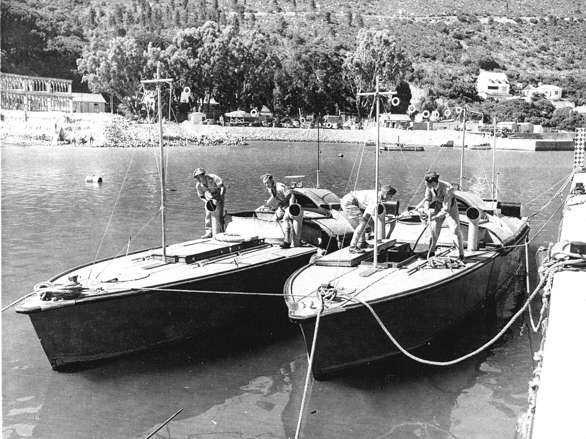 The two armoured boats at their moorings A number of these vessels were specially adapted to meet the peculiar needs of the operational conditions. During September there was concern about the water level in Lake St Lucia and an alternative operational base had to be found for the flying boats. Aircraft activity in Richards Bay drove off the hippos and resulted in the unhindered growth of underwater grasses. The two bomb scows that had been joined together to be used in lifting of moorings had to be modified to operate in these conditions. Perforated steel plates were welded in place under the screws to provide an area of weed free water as the vessel moved along. Crews on the armoured boats were paid marginally more for the danger and extreme discomfort they faced in these vessels. The crew consisting of Chief, wireless operator and engineer, operated from a cramped and hot, closed in cabin. The remaining compartments were filled with Onozote. This was a hard rubber compound made from 3ft by 1ft by 3 inch sheets, that was designed to improve the buoyancy ofthe craft in the event of a hit. This only happened on two occasions, and only once was any water shipped. These boats had a tendency to roll over if filled with water and therefore the armour was designed to drop off, ifthe retaining pins had been removed before putting to sea. Developments in technology meant that the False Bay range was no longer fully suitable for bombing practice. As a result Malgas I and II were withdrawn in December 1942 and early 1943. These vessels were reconstructed, the armour and centre engine was removed and the deck and wheelhouse were rebuilt. Re- commissioned as PLI and PL2, they proved to be better suited to inshore rescue work and bombing range patrols. They were also used for crew training, so freeing up the larger boats for rescue operations.
Post WarAt the end of the war, the Marine Craft Wing was reduced to a Squadron and as the launches became due for major refits, or when repair no was longer viable, they were put up for sale. R10 was cut up at Ciordon's Bay and the sale of RO followed shortly after. Her Merlins had been removed and sold separately.By 1948 R1, 3, 4, 5, 6, 7 and 8 had gone and by 1955 only R2, 9, 11, 18, 19 and 20 still remained. Active bases were reduced to Gordon's Bay (Repair Base) and Langebaan (to support the training flights from AFB Langebaan). Most of the activity took place in the Langebaan region, as the SAAF used the range at Tooth Rock for air to ground gunnery training. Gordon's Bay remained the major maintenance unit, but shared its space with the General Botha Nautical Training School. During this period the Squadron Headquarters were transferred to Robben Island.
 R9 - note the Castle insignia. The primary function of the unit had always been to have Air Sea Rescue Launches (ASRLs) standing by to react to any emergency involving aircraff operating from the training school at AFB Langebaanweg. The only time this occurred was during training for the Korean War. A Spitfire, used to train pilots to fly the Mustang went down 12 nautical miles offshore and the crew of a launch pulled the pilot from the icy Atlantic. During 1957 Commander Boyle was tasked with the closing of Gordon's Bay. The repair unit transferred to Langebaan and the Squadron became Motor Boat Flight attached to AFS Langebaan, equipped with 4 Miami class vessels. Its mason for existence was its close proximity to the Air Force gunnery and bombing ranges around the Saldanha area.
New craft
|

|
By the late 1950's it was becoming evident that the range of the
Miami class was insufficient. The Air Force thus decided to
purchase some new vessels and approached Krogerwerft in
Rendsburg to supply two boats. This company had constructed
similar types of launch for both the German government and the
RAF.
The final design was a 30 metre launch, displacing 87 tonnes and powered by two V12 Maybach-Mercedes diesel engines of 2240 hp each - giving a top speed of about 33 knots. The vessels were equipped with an operating table (thankfully never used) and a thermal bath system (also never used operationally, as survivors seemed to do better when warmed in the engine room). The first ship, R30, also known fondly as "Brigitte", the name of the daughter of Herr Bauer the MD of Krogerwerft who launched her, arrived in Cape Town aboard a cargo vessel in 1961. She was unloaded and the men of 1 Motorboat Squadron sailed her up to Langebaan with an Alouette helicopter hovering above taking photographs. She came around Schaapen Island doing about 18 knots, presenting a 'huge' presence, and being almost three times the size ofthe Miamis. Her black hull and grey upperworks dwarfed the jetty at Langebaan. In 1962 her sister, R31 was delivered and two of the Miamis were sold. These boats were required to be alongside to keep power on the gyros and being powered by diesel, the engines had to be kept hot. This was a significant difference to the petrol- powered Miamis, which were able to reach full speed on cold engines. With these two vessels, the No 1 Motorboat squadron of the SAAF (which later became the Marine Craft Unit) forged an enviable record. No distress call was ever unanswered. When other vessels refused to put to sea, these boats would go out looking for the lost, the shipwrecked and the distressed mariners around our coast. The Shackletons were often the crashboat's "eye in the sky" and they worked together in the rescue function on almost every rescue. Crews spent many hours waiting at sea for the weather to clear so that flying could commence and then spent many furher hours until exercises were finished. Compensation for the long hours at sea was the excitement associated with observing fighter pilots pitting their skills against each other or attacking ground targets. The Unit itself was the smallest independent unit in the SADF, with 28 men and four crash boats plus 5 smaller inshore rescue and service vessels. They were aided by a small number of National Servicemen in the later years. All servicing, slipping etc. was done at the base. Any number of Chiefs of the SAAF, repeatedly remarked upon the morale of this unit. Very few unit transfers took place and they became one of the most professional military outfits the SAAF ever saw.
TransferredOn 1 November 1969, the Marine Craft Unit was transferred to the South African Navy lock, stock and barrel as a going concern. A special naval unit, SAS Flamingo, was established. Air Force members took on Navy uniforms, R30 became P1552, R31 became P1551 and R9 became P1553. Commander M.T. Boyle notes that the Flamingo is mainly an inland bird and it would probably have been more appropriate to have named the unit Malmok, after the sea bird and as the first vessel of the original unit.During the 1960's it was found that the larger launches, ideal for long range deep sea operations, were not suitable for close inshore work. They required large crews and most of the time they patrolled bombing ranges and towed targets. The Miami class boat was more suitable for aircraft training. It was decided to procure two new 19,6m Fairey Marine Tracker craft with the same hull shape as the Miami boats. In 1971 and 1973 P1554 and P1555 were taken into service and R1553 (R9) was sold. Although used mainly for range clearance and safety work, the launches were called out from time to time for rescue missions. P1551 went to the assistance ofthe tanker Georgios V 500 miles west of Walvis Bay, where an engine room explosion had badly burned eleven men. The trip from Langebaan to Walvis, in heavy weather, was covered in two days. After taking on board Doctor Mervyn Jordaan, medical supplies and more fuel, she set sail for the tanker. To get the doctor aboard W01 Warner Baxter and Jerry Heydenrich guide the Captain into bringing R30 right alongside and when the two decks got level, and the waves were enormous, they threw the doctor onto the tanker's deck. Warner Baxter then went up the very unsteady ladder with the medical supplies. The doctor remained aboard the tanker until she was towed into Walvis. All eleven men, including three with 75% burns survived. In March 1987 the facilities of SAS Flamingo were handed over to the SA Army and the unit moved to the Naval Base at Saldanha. In 1988 P1552, ex R30, ex Brigitte was lost when she was run into Tooth Rock at speed. Many considered this an almost unforgivable action as Tooth Rock had been an Air Force firing range since World War 2 and crash boats had performed range clearance duty in that area since their inception
Post ServiceOf the Miamis sold it is known that four were named Rainbow, Ziller, Zest and Seaforth. Hugh Tevis, the owner of Rainbow, sold the original motors and re-engined the boat before using it in trips to Seal Island in the 1950's. It subsequently went to Durban where it was used during the shark scares of the time. The Ziller became the Bonnie Jean and in 1962, joined the Rainbow in Durban.
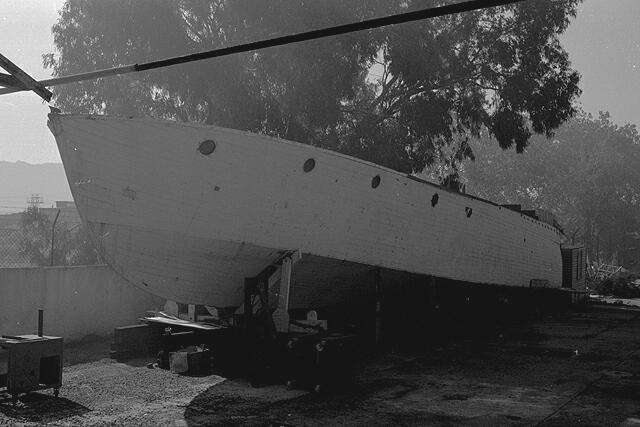 Unknown crash boat hull lying in Diep River - 1970's The Seaforth travelled to Mossel Bay in 1955 for use as a fishing boat. She was damaged in the famous storm of 1966 and was pulled up onto the beach. Harry Dilley made an offer to buy the motors. On his arrival at Mossel Bay he found that the vessel had been rolled over and he had to travel back the following weekend and cut the motors and gearboxes out of the wreck. These Detroit diesels were installed in Zest in 1966. After its purchase by a family estate, the Zest (R4) was purchased by Ian Garlick and converted for day fishing trips and at the time two General Motors engines were installed. A Norwegian Whaler Captain, who planned to use it for runs to Seal Island, subsequently bought it. He sold it onto Tex Ferriera of Northern Rhodesia (Zambia). Harry Dilley then purchased the vessel, which by then had suffered a damaged gearbox. This was subsequently replaced with equipment removed from the Seaforth. During the 1967 Arab Israeli War, Zest was kept fully employed servicing the ships in the roadstead. A notable period in her history was the servicing of the repair of the tanker Fina Brittania. During 1972/73 Zest transported 28000 men, 1000 tons of fresh water and an untold quantity of materials. She was used as the liberty boat for the crew and ran the last trip at Olh00, after the last train from Cape Town arrived in Simonstown. The original Detroit engines from the Zest am still hard at work in the vessel Northstar, which operates out of Cape Town harbour. In Durban Len Pinchen and Deryck Upton purchased six boats for an average price of 500 pounds. These were to be used for fishing and were sailed to Durban from Langebaan. The boats were christened, Isle of Capri I, II and III, the Welkom, the Ooster and the Sea Joy.
 Zest in 60ft breakers and winds of 85 knots, 75 miles due South of Mossel bay The boats had been built with planking, a sheet of canvas and white lead and then further planking, using 1 % inch screws to hold it all together. They required continual maintenance as electrolysis took over and the screws had to be replaced with rivets. When the rubber fuel tanks were removed, labels indicating that aviation fuel should be used were still in place. Sea Joy (R16) was purchased by a Mr Wolf and converted to a luxury boat. He hired a crew and they and his friends sailed it to the then Lourenco Marques. On the voyage the passengers were severely ill and flew back to Johannesburg rather than risk further discomfort. The hired crew returned the vessel to Durban and she lay moored at the rowing club for a long time until bought by Upton and Pinchen. She was sold on to Sarie Marais Ferries, originally known as Springbok Ferries, who also owned the Rainbow. Deryck Upton's son Rob eventually managed the operation and subsequently purchased it twenty two years ago and still runs it today. Sea Joy became very dilapidated through the nature of her structure and when Rob purchased the business from Murray and Roberts, he did not take the boat but was tasked to look after it. The original wheel has pride of place in his study. One ofthe M&R companies removed the engines and the boat lay there. Plans to have her scrapped were well advanced but were cancelled when a buyer appeared and purchased the hulk for R3000. The new owner spent ten years rebuilding the boat internally, putting in cabins and luxury fiittings but never attended to the structure itself. He had installed two very large and heavy GM motors. It is believed that the boat was sailed to the Comores over a number of days. It was evident that the crew realised thas it would only be safe to travel in calm weather. She was turned into a restaurant and it is thought that recently an American has purchased a half share in the restaurant. Another resident of Durban was The Queen, a boat owned by a retired Colonel who used it for fishing. It was extremely noisy and smokey. He used the boat for a few years until one day while fishing in calm seas she caught alight and sank. The crew were all rescued by nearby fellow fisherman. The Isle of Capri I sank at her moorings in Durban and as she was being salvaged her back broke and she was broken up in May 1999. A far more dramatic fate awaited Isle of Capri II. In 1972 she received a call to tow a boat from Richard's Bay. During the tow high seas came up. Heading into the sea her Skipper Deryck Upton faced a monstrous wave. He went over the wave, with the tow line going through it, but could not keep, ahead. It crashed down on the stern ofthe boat and cut the isle of Capri II in half. The crew abandoned ship and speplt eight hours in a life raft until picked up by a trawler. The Isle of Capri III and Welkom continue to be used as pleasure boats. The registration papers of the former boat state that she was built in Britain and therefore it must be assumed that she is RO. Miami craft built to last only a few years continue to serve.
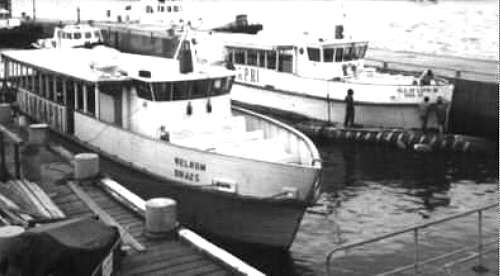 Two surviving boats in Durban 1999. It is possible that the furthest vessel was R0
Bibliography
In Conversation -Thank you for your time and memories
Additional research and assistance
|
||||||||||||||||||||||||||||||||||||||||||||||||||||||||||||||||||||||||||||||||||||||||||||||||||||||||||
Friends of the SAAF Museum (Cape Town)
Friends of the SAAF Museum (Pretoria)